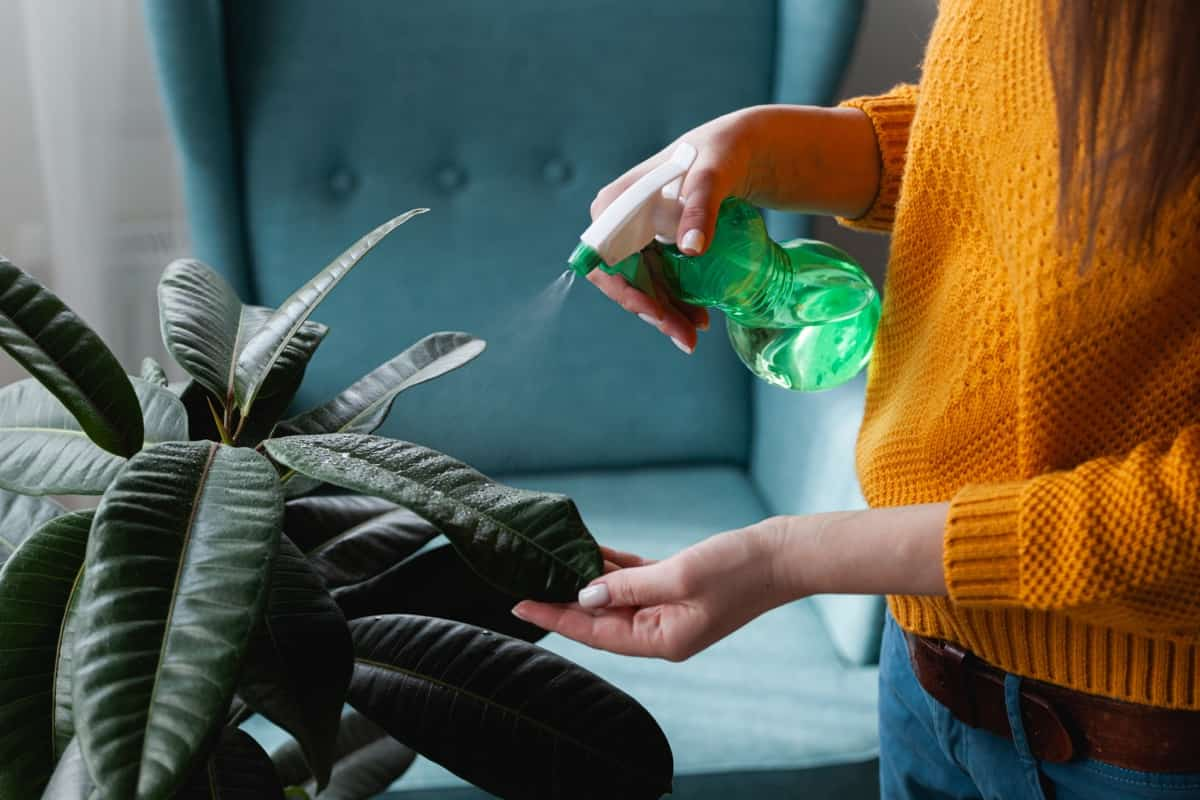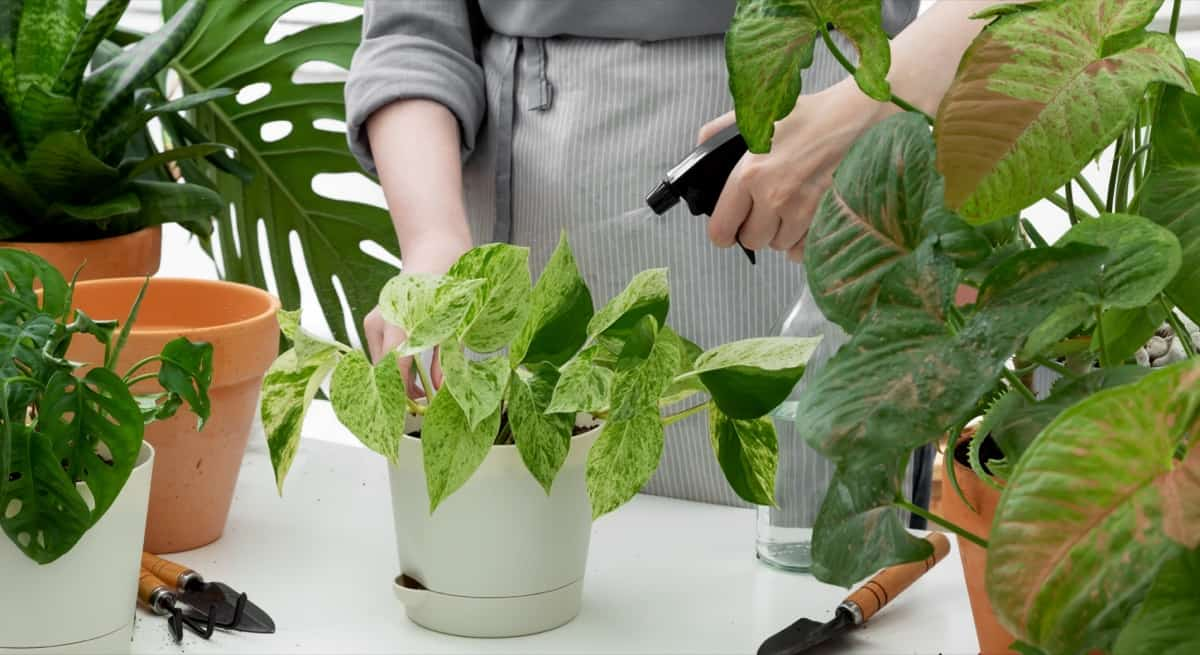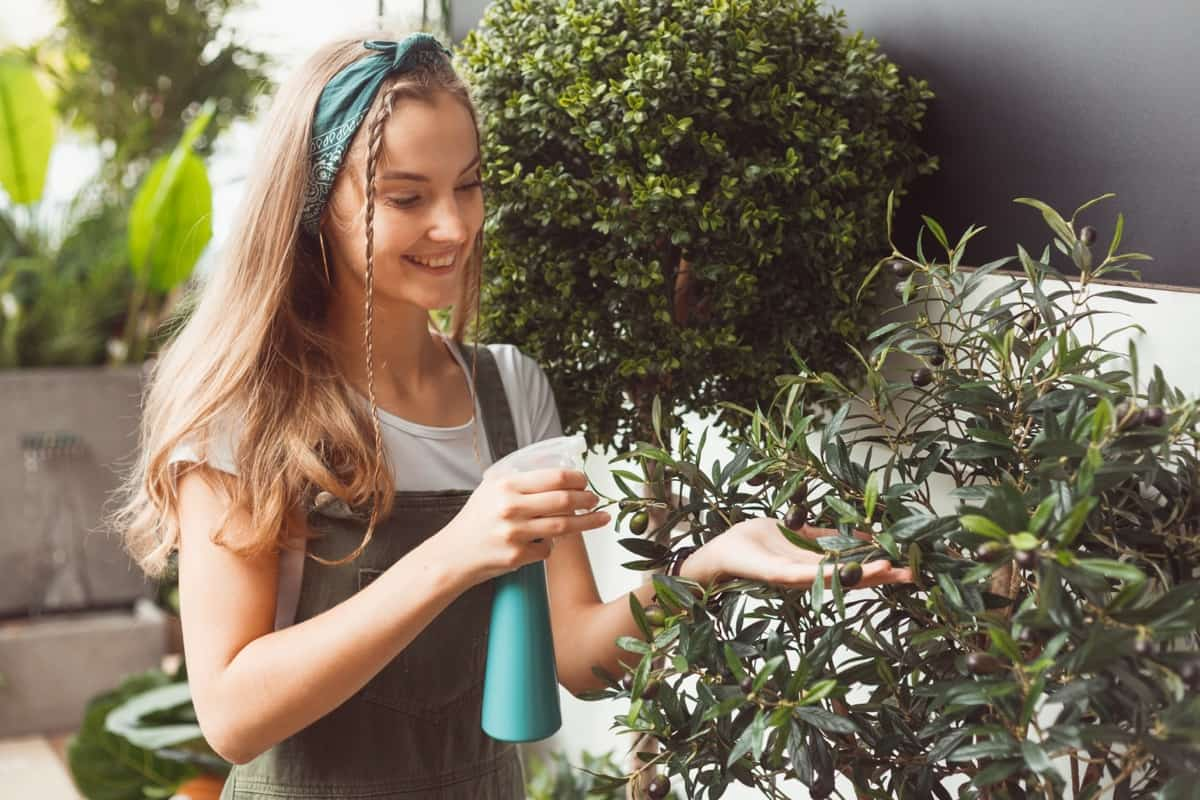Addressing brown spots on houseplant leaves requires careful observation with different remedies for each situation. Overwatering is one of the main causes of brown spots on the leaves of indoor plants. You can effectively treat brown spots on houseplant leaves by taking these below steps and implementing natural remedies.

How to Treat Brown Spots on Houseplants Naturally
Fungal Infections Causing Brown Spots on Houseplant Leaves
Fungal infections can be a common cause behind those unsightly brown spots on your houseplant leaves. These organisms thrive in warm, moist environments, making indoor plants the perfect breeding ground. What causes brown spots on indoor plants? One of the most common fungal diseases that causes brown spots is leaf spot disease. Various fungi, including Alternaria, Cercospora, and Septoria species, cause this condition.
These fungi typically enter through wounds or natural openings on the plant’s leaves and spread rapidly. Creating an environment that discourages their growth is crucial to combat fungal infections naturally. Applying organic fungicides containing ingredients like neem oil or copper soap can also help control fungal infections effectively without harsh chemicals.
Nutrient Deficiencies Leading to Brown Spots on Houseplant Leaves
- Nitrogen deficiency – It plays a crucial role in plant growth and development, so plants may develop pale or yellowing leaves with brown spots when insufficient.
- Iron deficiency – Iron is essential for chlorophyll production, giving plants green color. Without enough iron, leaves may turn yellow or develop brown spots.
- Phosphorus and potassium deficiencies – It can also contribute to brown spots on houseplant leaves. Phosphorus helps with root development and energy transfer within the plant, while potassium aids overall plant health and disease resistance.
- To address these nutrient deficiencies naturally, you can consider adding organic fertilizers or compost rich in nitrogen, iron, phosphorus, and potassium to replenish the lacking nutrients in your soil. Adjusting pH levels through amendments like dolomite lime or sulfur can help improve plant nutrient availability.
Pests Causing Brown Spots on Houseplant Leaves
- Spider mites – These can quickly infest your plants and suck the chlorophyll out of their leaves, resulting in those tell-tale brown spots.
- Mealybug – These fuzzy white insects love to feast on plant sap, causing damage not only to the leaves, stems, and flowers. Their feeding activity weakens plants and makes them more susceptible to other diseases.
- Aphids – These are other common pest that can leave behind brown spots on houseplant leaves. These small insects feed by piercing the plant tissue and sucking out its juices, leading to discoloration and distortion of affected foliage.
- You can use insecticidal soap to control brown spots on plants. These organic remedies help control infestations without harming beneficial insects or pollinators. Regularly inspecting your plants for any signs of pests and promptly addressing any issues will go a long way in preventing brown spots caused by these pests.
In case you missed it: Herbal Remedies for Houseplant Pests and Diseases: Prevention, Treatment, and Solutions

Overwatering Causing Brown Spots on Houseplant Leaves
Overwatering is a common mistake many houseplant owners make, leading to brown spots on the leaves. When plants are watered too frequently or if there is poor drainage in the pot, excess moisture accumulates in the soil. This creates a perfect environment for fungal pathogens to thrive. The excessive moisture causes the plant’s roots to become waterlogged, leading to root rot. As a result, the roots cannot absorb nutrients properly, causing deficiencies that manifest as brown spots on the leaves.
To prevent overwatering, have well-draining soil and pots with drainage holes. Before watering your plant, check if the top inch of soil has dried out. If it hasn’t, hold off on watering until it does. Different plants have different watering requirements; some may require more frequent watering, while others prefer drier conditions by understanding your plant’s specific requirements and adjusting your watering routine accordingly.
Sunburn Causing Brown Spots on Houseplant Leaves
- Exposing your houseplants to excessive sunlight can lead to a condition known as sunburn, which can cause unsightly tiny brown spots on plant leaves. Just like human skin, plant leaves can also suffer from the damaging effects of too much direct sunlight.
- When plants are placed in an area with intense sunlight, especially during peak hours of the day, their delicate leaves may become scorched. High levels of ultraviolet (UV) radiation can penetrate and damage the cells within the leaf tissues, resulting in brown spots.
- If you notice brown spots caused by sunburn on your houseplant’s leaves, relocate them to a spot with less direct sunlight. Trim off any severely damaged foliage but avoid pruning excessively, as this can stress the plant further.
Improper Humidity Causing Brown Spots on Houseplant Leaves
- Maintaining the right humidity is crucial for the health of your houseplants. When humidity becomes too high or too low, it can lead to brown spots on their leaves.
- Excess moisture in the air allows fungi spores to thrive and attack your plants’ foliage.
- On the other hand, low humidity can cause water loss through transpiration to exceed water absorption by roots. This imbalance leads to dehydration and results in brown spots appearing on leaves.
- It would help if you found the right balance to prevent improper humidity from causing brown spots. Invest in a hygrometer to monitor indoor humidity levels regularly. If it’s too high, increase ventilation by opening windows or using fans. If it’s too low, consider using a humidifier or placing trays filled with water near your plants. Remember that different plant species have varying preferences regarding humidity levels.
Diseases Causing Brown Spots on Houseplant Leaves
One common disease that causes brown spots is fungal leaf spots. This occurs when fungi spores land on the leaves and grow, resulting in circular or irregular-shaped brown lesions. Another disease is bacterial leaf blight, which causes water-soaked lesions that eventually turn brown. Preventing these diseases involves good plant care practices such as avoiding overwatering, providing proper ventilation, and maintaining optimal humidity levels.
In case you missed it: How to Grow and Care for a Christmas Cactus Houseplant: Instructions for Beginners

Additionally, removing infected leaves promptly can help prevent further spread of the disease. Treating these diseases naturally involves using organic fungicides or bactericides from ingredients like neem oil or copper-based solutions. However, prevention is always better than cure when dealing with diseases causing brown spots on houseplant leaves.
Lack of Proper Ventilation Causing Brown Spots on Houseplant Leaves
- Proper ventilation is important for the health of your houseplants. When plants are deprived of fresh air and circulation, they can develop brown spots on their leaves. This occurs because stagnant air creates a humid environment that encourages the growth of fungi and bacteria.
- Without adequate airflow, moisture tends to linger around the leaves, making them susceptible to fungal diseases like leaf spots. These diseases manifest as small brown or black spots gradually spreading across the foliage.
- If you notice brown spots caused by poor ventilation, relocate your plant to a more open space with better air circulation. Regularly pruning dead leaves will also help improve airflow and reduce the risk of brown spots forming.
Stress Factors Causing Brown Spots on Houseplant Leaves
These stress factors can include temperature changes, humidity fluctuations, and even physical damage caused by mishandling or improper care. Plants exposed to stressful conditions make them more susceptible to diseases and infections. As a result, brown spots may start appearing on the leaves as a sign of distress. It’s important to promptly identify and address these stress factors to prevent further damage and ensure the health of your houseplants. To minimize stress factors for your houseplants;
In case you missed it: Tree, Houseplant, and Shrub Fertilizer Spikes: Everything You Need to Know About

- Maintain consistent temperatures: Avoid exposing your plants to extreme temperature changes or drafts.
- Provide adequate humidity: Monitor the humidity levels in your home and use methods such as misting or placing trays with water near your plants.
- Handle with care: Be gentle when moving or handling your houseplants to avoid causing physical damage.
- Maintain proper watering habits: Water your plants regularly but ensure not to overwater them as they can lead to root rot and create ideal conditions for fungal growth.
Conclusion
Brown spots on leaves can be a common problem for houseplant owners. When plants receive excessive water and lack proper airflow and sunlight, the moist conditions create an ideal environment for these fungi to thrive. Insufficient airflow and sunlight can also contribute to the development of brown spots. Additionally, they require sufficient light exposure to maintain healthy foliage.
- Ultimate Guide to Ossabaw Island Hog: Breeding, Raising, Diet, and Care
- Ultimate Guide to Juliana Pig: Raising Facts, Size, Diet, Care, and Lifespan
- Raising Lleyn Sheep: Disadvantages, Price, Uses, Characteristics, and Care
- Ultimate Guide to Meishan Pig: Breed Facts, Breeding, Raising, and Care
- Ultimate Guide to Teacup Pigs: Raising, Diet, Lifespan, Cost, and Care
- Guide to Raising Poll Dorset Sheep: Facts, Profile, Characteristics, Uses, and Care
- Ultimate Guide to Bighorn Sheep: Characteristics, Diet, Lifespan, Breeding, and Lifecycle
- Ultimate Guide to Raising Katahdin Sheep: Farming Facts, Breed Profile, Uses, and Care
- Ultimate Guide to Raising Oreo Cows: Belted Galloways Farming Facts, Profile, Uses, and Care